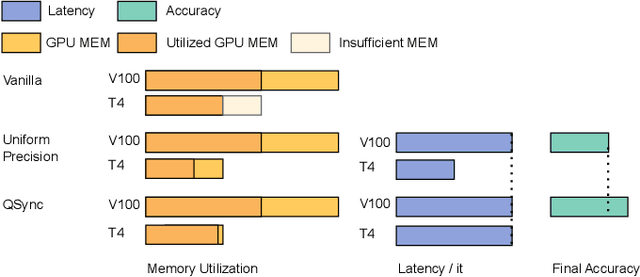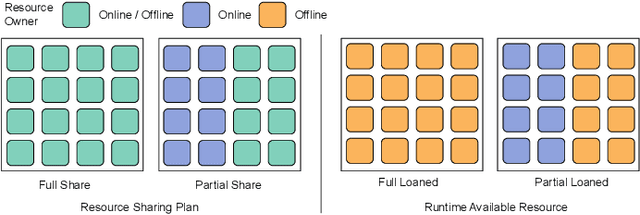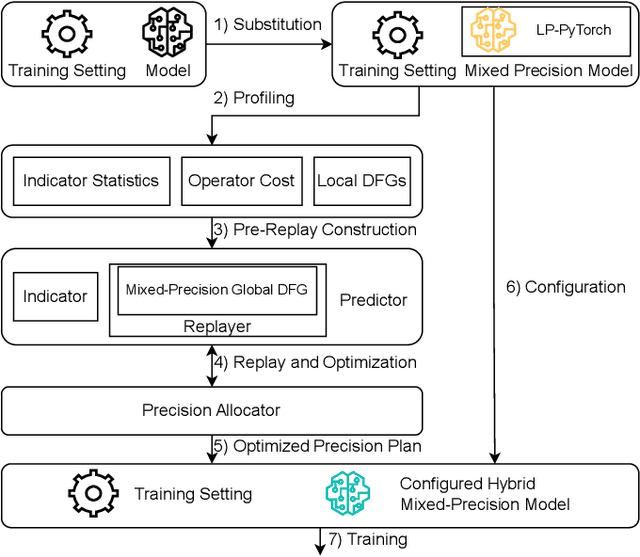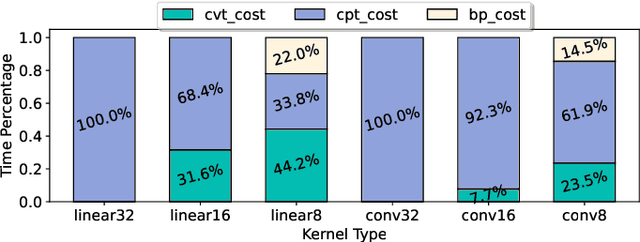Yanghua Peng
ByteDance
Laminar: A Scalable Asynchronous RL Post-Training Framework
Oct 14, 2025Abstract:Reinforcement learning (RL) post-training for Large Language Models (LLMs) is now scaling to large clusters and running for extended durations to enhance model reasoning performance. However, the scalability of existing RL frameworks is limited, as extreme long-tail skewness in RL trajectory generation causes severe GPU underutilization. Current asynchronous RL systems attempt to mitigate this, but they rely on global weight synchronization between the actor and all rollouts, which creates a rigid model update schedule. This global synchronization is ill-suited for the highly skewed and evolving distribution of trajectory generation latency in RL training, crippling training efficiency. Our key insight is that efficient scaling requires breaking this lockstep through trajectory-level asynchrony, which generates and consumes each trajectory independently. We propose Laminar, a scalable and robust RL post-training system built on a fully decoupled architecture. First, we replace global updates with a tier of relay workers acting as a distributed parameter service. This enables asynchronous and fine-grained weight synchronization, allowing rollouts to pull the latest weight anytime without stalling the actor's training loop. Second, a dynamic repack mechanism consolidates long-tail trajectories onto a few dedicated rollouts, maximizing generation throughput. The fully decoupled design also isolates failures, ensuring robustness for long-running jobs. Our evaluation on a 1024-GPU cluster shows that Laminar achieves up to 5.48$\times$ training throughput speedup over state-of-the-art systems, while reducing model convergence time.
MegaScale-MoE: Large-Scale Communication-Efficient Training of Mixture-of-Experts Models in Production
May 19, 2025Abstract:We present MegaScale-MoE, a production system tailored for the efficient training of large-scale mixture-of-experts (MoE) models. MoE emerges as a promising architecture to scale large language models (LLMs) to unprecedented sizes, thereby enhancing model performance. However, existing MoE training systems experience a degradation in training efficiency, exacerbated by the escalating scale of MoE models and the continuous evolution of hardware. Recognizing the pivotal role of efficient communication in enhancing MoE training, MegaScale-MoE customizes communication-efficient parallelism strategies for attention and FFNs in each MoE layer and adopts a holistic approach to overlap communication with computation at both inter- and intra-operator levels. Additionally, MegaScale-MoE applies communication compression with adjusted communication patterns to lower precision, further improving training efficiency. When training a 352B MoE model on 1,440 NVIDIA Hopper GPUs, MegaScale-MoE achieves a training throughput of 1.41M tokens/s, improving the efficiency by 1.88$\times$ compared to Megatron-LM. We share our operational experience in accelerating MoE training and hope that by offering our insights in system design, this work will motivate future research in MoE systems.
Seed1.5-VL Technical Report
May 11, 2025Abstract:We present Seed1.5-VL, a vision-language foundation model designed to advance general-purpose multimodal understanding and reasoning. Seed1.5-VL is composed with a 532M-parameter vision encoder and a Mixture-of-Experts (MoE) LLM of 20B active parameters. Despite its relatively compact architecture, it delivers strong performance across a wide spectrum of public VLM benchmarks and internal evaluation suites, achieving the state-of-the-art performance on 38 out of 60 public benchmarks. Moreover, in agent-centric tasks such as GUI control and gameplay, Seed1.5-VL outperforms leading multimodal systems, including OpenAI CUA and Claude 3.7. Beyond visual and video understanding, it also demonstrates strong reasoning abilities, making it particularly effective for multimodal reasoning challenges such as visual puzzles. We believe these capabilities will empower broader applications across diverse tasks. In this report, we mainly provide a comprehensive review of our experiences in building Seed1.5-VL across model design, data construction, and training at various stages, hoping that this report can inspire further research. Seed1.5-VL is now accessible at https://www.volcengine.com/ (Volcano Engine Model ID: doubao-1-5-thinking-vision-pro-250428)
OVERLORD: Ultimate Scaling of DataLoader for Multi-Source Large Foundation Model Training
Apr 14, 2025Abstract:Modern frameworks for training large foundation models (LFMs) employ data loaders in a data parallel paradigm. While this design offers implementation simplicity, it introduces two fundamental challenges. First, due to the quadratic computational complexity of the attention operator, the non-uniform sample distribution over data-parallel ranks leads to a significant workload imbalance among loaders, which degrades the training efficiency. This paradigm also impedes the implementation of data mixing algorithms (e.g., curriculum learning) over different datasets. Second, to acquire a broad range of capability, LFMs training ingests data from diverse sources, each with distinct file access states. Colocating massive datasets within loader instances can easily exceed local pod memory capacity. Additionally, heavy sources with higher transformation latency require larger worker pools, further exacerbating memory consumption. We present OVERLORD, an industrial-grade distributed data loading architecture with three innovations: (1) A centralized and declarative data plane, which facilitates elastic data orchestration strategy, such as long-short context, multimodal, and curriculum learning; (2) Disaggregated multisource preprocessing through role-specific actors, i.e., Source Loaders and Data Constructors, leveraging autoscaling for Source Loaders towards heterogeneous and evolving source preprocessing cost; (3) Shadow Loaders with differential checkpointing for uninterrupted fault recovery. Deployed on production clusters scaling to multi-thousand GPU, OVERLORD achieves: (1) 4.5x end-to-end training throughput improvement, (2) a minimum 3.6x reduction in CPU memory usage, with further improvements to be added in later experiments.
Seaweed-7B: Cost-Effective Training of Video Generation Foundation Model
Apr 11, 2025Abstract:This technical report presents a cost-efficient strategy for training a video generation foundation model. We present a mid-sized research model with approximately 7 billion parameters (7B) called Seaweed-7B trained from scratch using 665,000 H100 GPU hours. Despite being trained with moderate computational resources, Seaweed-7B demonstrates highly competitive performance compared to contemporary video generation models of much larger size. Design choices are especially crucial in a resource-constrained setting. This technical report highlights the key design decisions that enhance the performance of the medium-sized diffusion model. Empirically, we make two observations: (1) Seaweed-7B achieves performance comparable to, or even surpasses, larger models trained on substantially greater GPU resources, and (2) our model, which exhibits strong generalization ability, can be effectively adapted across a wide range of downstream applications either by lightweight fine-tuning or continue training. See the project page at https://seaweed.video/
Goku: Flow Based Video Generative Foundation Models
Feb 10, 2025



Abstract:This paper introduces Goku, a state-of-the-art family of joint image-and-video generation models leveraging rectified flow Transformers to achieve industry-leading performance. We detail the foundational elements enabling high-quality visual generation, including the data curation pipeline, model architecture design, flow formulation, and advanced infrastructure for efficient and robust large-scale training. The Goku models demonstrate superior performance in both qualitative and quantitative evaluations, setting new benchmarks across major tasks. Specifically, Goku achieves 0.76 on GenEval and 83.65 on DPG-Bench for text-to-image generation, and 84.85 on VBench for text-to-video tasks. We believe that this work provides valuable insights and practical advancements for the research community in developing joint image-and-video generation models.
HybridFlow: A Flexible and Efficient RLHF Framework
Sep 28, 2024



Abstract:Reinforcement Learning from Human Feedback (RLHF) is widely used in Large Language Model (LLM) alignment. Traditional RL can be modeled as a dataflow, where each node represents computation of a neural network (NN) and each edge denotes data dependencies between the NNs. RLHF complicates the dataflow by expanding each node into a distributed LLM training or generation program, and each edge into a many-to-many multicast. Traditional RL frameworks execute the dataflow using a single controller to instruct both intra-node computation and inter-node communication, which can be inefficient in RLHF due to large control dispatch overhead for distributed intra-node computation. Existing RLHF systems adopt a multi-controller paradigm, which can be inflexible due to nesting distributed computation and data communication. We propose HybridFlow, which combines single-controller and multi-controller paradigms in a hybrid manner to enable flexible representation and efficient execution of the RLHF dataflow. We carefully design a set of hierarchical APIs that decouple and encapsulate computation and data dependencies in the complex RLHF dataflow, allowing efficient operation orchestration to implement RLHF algorithms and flexible mapping of the computation onto various devices. We further design a 3D-HybridEngine for efficient actor model resharding between training and generation phases, with zero memory redundancy and significantly reduced communication overhead. Our experimental results demonstrate 1.53$\times$~20.57$\times$ throughput improvement when running various RLHF algorithms using HybridFlow, as compared with state-of-the-art baselines. HybridFlow source code is available at https://github.com/volcengine/verl.
Optimus: Accelerating Large-Scale Multi-Modal LLM Training by Bubble Exploitation
Aug 07, 2024



Abstract:Multimodal large language models (MLLMs) have extended the success of large language models (LLMs) to multiple data types, such as image, text and audio, achieving significant performance in various domains, including multimodal translation, visual question answering and content generation. Nonetheless, existing systems are inefficient to train MLLMs due to substantial GPU bubbles caused by the heterogeneous modality models and complex data dependencies in 3D parallelism. This paper proposes Optimus, a distributed MLLM training system that reduces end-to-end MLLM training time. Optimus is based on our principled analysis that scheduling the encoder computation within the LLM bubbles can reduce bubbles in MLLM training. To make scheduling encoder computation possible for all GPUs, Optimus searches the separate parallel plans for encoder and LLM, and adopts a bubble scheduling algorithm to enable exploiting LLM bubbles without breaking the original data dependencies in the MLLM model architecture. We further decompose encoder layer computation into a series of kernels, and analyze the common bubble pattern of 3D parallelism to carefully optimize the sub-millisecond bubble scheduling, minimizing the overall training time. Our experiments in a production cluster show that Optimus accelerates MLLM training by 20.5%-21.3% with ViT-22B and GPT-175B model over 3072 GPUs compared to baselines.
ByteCheckpoint: A Unified Checkpointing System for LLM Development
Jul 29, 2024



Abstract:The development of real-world Large Language Models (LLMs) necessitates checkpointing of training states in persistent storage to mitigate potential software and hardware failures, as well as to facilitate checkpoint transferring within the training pipeline and across various tasks. Due to the immense size of LLMs, saving and loading checkpoints often incur intolerable minute-level stalls, significantly diminishing training efficiency. Besides, when transferring checkpoints across tasks, checkpoint resharding, defined as loading checkpoints into parallel configurations differing from those used for saving, is often required according to the characteristics and resource quota of specific tasks. Previous checkpointing systems [16,3,33,6] assume consistent parallel configurations, failing to address the complexities of checkpoint transformation during resharding. Furthermore, in the industry platform, developers create checkpoints from different training frameworks[23,36,21,11], each with its own unique storage and I/O logic. This diversity complicates the implementation of unified checkpoint management and optimization. To address these challenges, we introduce ByteCheckpoint, a PyTorch-native multi-framework LLM checkpointing system that supports automatic online checkpoint resharding. ByteCheckpoint employs a data/metadata disaggregated storage architecture, decoupling checkpoint storage from the adopted parallelism strategies and training frameworks. We design an efficient asynchronous tensor merging technique to settle the irregular tensor sharding problem and propose several I/O performance optimizations to significantly enhance the efficiency of checkpoint saving and loading. Experimental results demonstrate ByteCheckpoint's substantial advantages in reducing checkpoint saving (by up to 529.22X) and loading (by up to 3.51X) costs, compared to baseline methods.
QSync: Quantization-Minimized Synchronous Distributed Training Across Hybrid Devices
Jul 02, 2024



Abstract:A number of production deep learning clusters have attempted to explore inference hardware for DNN training, at the off-peak serving hours with many inference GPUs idling. Conducting DNN training with a combination of heterogeneous training and inference GPUs, known as hybrid device training, presents considerable challenges due to disparities in compute capability and significant differences in memory capacity. We propose QSync, a training system that enables efficient synchronous data-parallel DNN training over hybrid devices by strategically exploiting quantized operators. According to each device's available resource capacity, QSync selects a quantization-minimized setting for operators in the distributed DNN training graph, minimizing model accuracy degradation but keeping the training efficiency brought by quantization. We carefully design a predictor with a bi-directional mixed-precision indicator to reflect the sensitivity of DNN layers on fixed-point and floating-point low-precision operators, a replayer with a neighborhood-aware cost mapper to accurately estimate the latency of distributed hybrid mixed-precision training, and then an allocator that efficiently synchronizes workers with minimized model accuracy degradation. QSync bridges the computational graph on PyTorch to an optimized backend for quantization kernel performance and flexible support for various GPU architectures. Extensive experiments show that QSync's predictor can accurately simulate distributed mixed-precision training with <5% error, with a consistent 0.27-1.03% accuracy improvement over the from-scratch training tasks compared to uniform precision.
 Add to Chrome
Add to Chrome Add to Firefox
Add to Firefox Add to Edge
Add to Edge